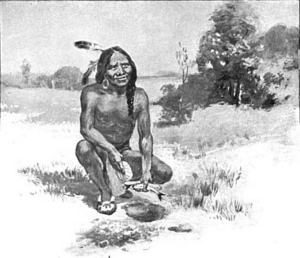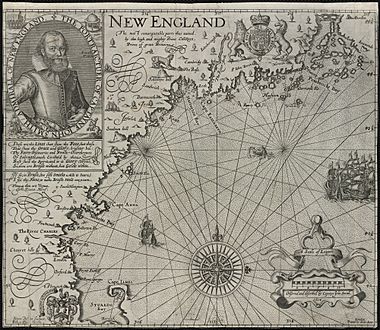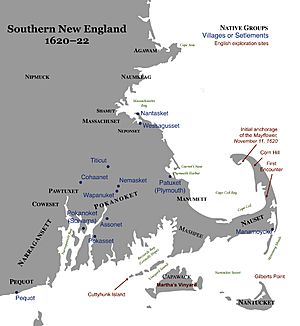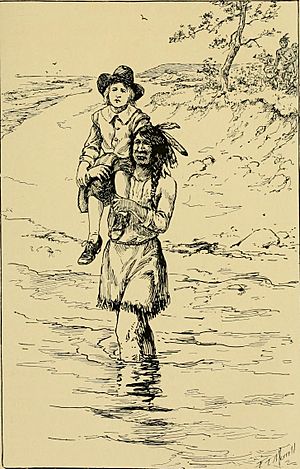Squanto facts for kids
Quick facts for kids
Tisquantum ("Squanto")
|
|
|---|---|

1911 illustration of Tisquantum ("Squanto") teaching the Plymouth colonists to plant maize.
|
|
| Born | c. 1585 |
| Died | late November 1622 O.S. Mamamoycke (or Monomoit)
(now Chatham, Massachusetts) |
| Nationality | Patuxet |
| Known for | Guidance, advice, and translation services to the Mayflower settlers |
Tisquantum (born around 1585, died late November 1622), often called Squanto, was a Native American from the Patuxet tribe. He is famous for helping the English Pilgrims who settled at Plymouth, Massachusetts in 1620. The Patuxet tribe lived on the coast of Cape Cod Bay. Sadly, most of them died from a terrible sickness, likely brought by earlier European visitors. Tisquantum was the last person left from his tribe.
Tisquantum was kidnapped by an English explorer named Thomas Hunt in 1614. Hunt took him to Spain and sold him as a slave. Luckily, some kind monks helped him and taught him. Tisquantum eventually traveled to England. He returned to America in 1619, only to find his village empty. He then went to live with the Wampanoag tribe.
When the Mayflower Pilgrims arrived in 1620, Tisquantum helped them. He spoke English and became a key link between the Pilgrims and the local Native Americans. He lived with the Pilgrims for about 20 months. During this time, he was their interpreter, guide, and advisor. He taught them how to grow native crops like corn and how to find furs for trade. These skills were very important for the Pilgrims' survival.
Contents
Who was Tisquantum?
Documents from the 1600s spell Tisquantum's name in different ways. Some call him Tisquantum, Tasquantum, or Tusquantum. Others use Squanto, Squantum, Tantum, or Tantam. The Pilgrim leader William Bradford nicknamed him "Squanto." Another Pilgrim, Edward Winslow, always called him Tisquantum, which historians believe was his true name.
Tisquantum's Early Life
We don't know much about Tisquantum's life before he met Europeans. Historians believe he was in his twenties or thirties when he was captured in 1614. This means he was likely born around 1585.
Native American Ways of Life

The Native American tribes in southern New England in the 1600s called themselves Ninnimissinuok. This word means "people" and shows they shared a common identity. Tisquantum's Patuxet tribe lived along the coast of Cape Cod Bay. He once told an English trader that there were about 2,000 Patuxet people.
These tribes spoke a language called Eastern Algonquian. Different dialects of this language were similar enough for tribes to understand each other. The word patuxet refers to the area where Plymouth, Massachusetts is now. It means "at the little falls."
Unlike tribes further north, the southern New England Algonquins were "sedentary cultivators." This means they stayed in one place and farmed. They grew enough maize (corn) for their own needs and to trade with other tribes. Their harvests were so good that they often helped the colonists when they didn't have enough food.
Native American groups were led by one or two chiefs, called sachems. Sachems decided where people could farm and managed trade. They also settled disagreements and collected food from harvests and hunts. They were also leaders in times of war.
Meeting Europeans
Native Americans in New England had met European explorers for almost 100 years before the Mayflower arrived in 1620. Fishermen from Europe began visiting the coast as early as 1581. These early meetings had big effects. Europeans might have brought diseases that the Native Americans had no protection against. When the Pilgrims arrived, they found entire villages empty because of these sicknesses.
Tisquantum's Abduction
In 1614, an English expedition led by John Smith explored the coast. Smith returned to England, leaving Thomas Hunt in charge of one ship. Hunt was supposed to collect fish, but he decided to capture Native Americans instead. He sailed to Plymouth harbor and tricked 20 Patuxet people, including Tisquantum, onto his ship. He promised to trade with them. Once they were on board, he captured them. He then sailed across Cape Cod Bay and kidnapped seven more people from the Nausets. Hunt then sailed to Málaga, Spain, to sell them as slaves.
According to one account, Hunt sold as many Native Americans as he could in Spain. But some monks found out what he was doing. They took the remaining Native Americans to teach them about Christianity. We don't know how long Tisquantum stayed in Spain or what he did there. Pilgrim Governor William Bradford said Tisquantum lived in England for "a good time" with a merchant named Master John Slanie.
Returning Home
Around 1619, Tisquantum sailed back to New England with Thomas Dermer, another explorer. They found that everyone in Tisquantum's home village of Patuxet had died from the sickness. So, they traveled inland to the village of Nemasket. Tisquantum then went to the village of Pokanoket, where Chief Massasoit lived. It's not known if Tisquantum and Massasoit had met before, but they became connected around this time.
Later, Native Americans attacked Dermer and Tisquantum on Martha's Vineyard. Dermer was badly hurt and died in Virginia. We don't know what happened to Tisquantum until he appeared to the Pilgrims in Plymouth Colony.
Life in Plymouth Colony
The Pilgrims settled at the former home of Tisquantum's Patuxet tribe. Tisquantum was living with the Pokanoket tribe, led by Chief Massasoit. Massasoit had a big decision to make: should he become friends with the Pilgrims, or try to drive them away? Tisquantum, who had lived in England, told Massasoit about the amazing things he had seen there. He urged Massasoit to make peace with the Pilgrims.
On March 16, 1621, a Native American named Samoset walked into the Pilgrim settlement. He spoke English and told them about the local tribes. The next day, Samoset returned with Tisquantum. They brought important news: Massasoit and 60 of his men were nearby. Tisquantum helped as a translator. He helped Edward Winslow talk to Massasoit. Winslow told Massasoit that King James wanted peace and trade.
After talking, the Pilgrims and Massasoit made a peace treaty. This treaty promised peace and mutual defense between them. Both sides kept this peace during Massasoit's lifetime.
Helping the Settlers Survive
After the treaty, Samoset and Tisquantum stayed with the Pilgrims. Tisquantum and Governor Bradford became good friends. Bradford saw Tisquantum as a special gift from God. Tisquantum taught the Pilgrims many survival skills. He showed them how to plant corn, where to fish, and how to find other useful things. He also guided them to new places for trade.
Tisquantum taught them how to plant corn using fish as fertilizer. This method became a regular practice for the Pilgrims. He also showed them how to get animal furs for trade. Bradford said that no one among them had ever seen a beaver skin until Tisquantum taught them. Trading furs became very important for the Pilgrims to pay back their financial supporters in England.
Tisquantum's Role in Diplomacy
Tisquantum was the only person who could speak both English and the local Native American languages. Because of this, the Pilgrims relied on him for all their dealings with the surrounding tribes. He was involved in every meeting for the 20 months he lived with them.
Visiting Massasoit
In July 1621, the Pilgrims sent Edward Winslow and Stephen Hopkins with Tisquantum to visit Massasoit. They wanted to make sure the peace treaty was still strong. They also wanted to explore the area and repay the corn they had taken from Native Americans the previous winter.
They gave Massasoit a red coat as a gift. Massasoit was thankful and promised that his 30 villages would remain peaceful and bring furs to Plymouth. The Pilgrims stayed for two days. Then, Tisquantum went to other villages to find more trading partners for the English.
Finding a Lost Boy
Later, a young Pilgrim boy named John Billington wandered off and got lost. Governor Bradford sent Tisquantum and others to find him. They learned the boy was with the Nauset tribe. Tisquantum helped them talk to the Nauset chief, Iyanough. The Pilgrims were kindly welcomed. They also met an old woman whose two sons had been kidnapped by Thomas Hunt, the same man who kidnapped Tisquantum. Winslow promised her that the Pilgrims would never treat Native Americans that way.
The Nauset chief, Aspinet, brought the boy back to the Pilgrims. This mission helped create a good relationship between the Pilgrims and the Cape Cod Native Americans.
Saving Tisquantum at Nemasket
The Pilgrims heard that Massasoit might have been captured by the Narragansett tribe. They also learned that another chief, Corbitant, was causing trouble at Nemasket. Corbitant was angry at Tisquantum for helping the Pilgrims make peace. He reportedly said, "If he were dead, the English had lost their tongue."
Tisquantum and Hobomok, another Native American living with the Pilgrims, went to Nemasket to find out more. Corbitant captured them. Hobomok escaped and ran back to Plymouth, thinking Tisquantum was dead.
Governor Bradford sent a group of armed men, led by Miles Standish, to Nemasket. They surprised the village at night. They found Tisquantum unharmed. Corbitant and his men had left. The Pilgrims warned the villagers that they would protect Massasoit's people, including Tisquantum and Hobomok. This action led to an even stronger peace. Many other chiefs came to make peace with the Pilgrims.
Meeting the Massachuset People
The Pilgrims decided to meet the Massachuset Native Americans, who had sometimes threatened them. Tisquantum and two other Native Americans went as interpreters. They met Chief Obbatinewat, who was a friend of Massasoit. Obbatinewat agreed to be loyal to King James if the Pilgrims protected him from his enemies.
They also visited the burial place of a chief named Nanepashemet. Tisquantum suggested they just take furs from the women they met, saying they were "bad people." But the Pilgrims insisted on trading fairly. The women sold them everything they had. The Pilgrims noticed that many islands in the harbor had been cleared, but all the people had died. They returned with many beaver furs.
Peace and Thanksgiving
By the fall of 1621, the Pilgrims were doing well. They had plenty of corn, fish, and fowl. Winslow wrote that the Native Americans were "very faithful in their Covenant of Peace with us." He said there was "great peace amongst the Indians themselves" because of the Pilgrims.
The First Thanksgiving
Governor Bradford wrote that they had a great harvest. Winslow described a time of celebration after the harvest. Bradford sent four men to hunt birds. Many Native Americans joined them, including Massasoit and 90 of his men. They stayed for three days. They killed five deer and gave them to the Pilgrims. Winslow wrote, "we are so farre from want, that we often wish you partakers of our plentie." This event became the basis for the tradition of "the first Thanksgiving."
Threat from the Narragansett
The peace treaties meant that many tribes became allies of the English. But this made the Narragansett tribe, who lived in Rhode Island, unhappy. In January 1622, the Narragansett sent a message to the English. A messenger arrived with a bundle of arrows wrapped in a rattlesnake skin. Tisquantum explained that this meant they wanted war.
Bradford bravely sent the rattlesnake skin back, filled with gunpowder and bullets. He sent a message saying they were ready to fight. This scared the Narragansett chief, Canonicus, so much that he refused to touch the skin. It was eventually returned to Plymouth.
Trouble with Tisquantum
Even with the bold response, the Pilgrims knew they were not safe. They built a strong fence around their settlement and posted guards. This work was hard, especially since they had little food.
False Alarms
In March, Hobomok, who still lived with the Pilgrims, warned them. He said the Massachuset and Narragansett tribes might attack. He also said Tisquantum was part of this plan. Hobomok claimed Tisquantum would try to trick the Pilgrims into Native American houses to trap them.
Governor Bradford decided they still had to go on a trading trip. Their food supplies were very low. So, Miles Standish and ten men set off with both Tisquantum and Hobomok.
Soon after they left, a Native American from Tisquantum's family came running to Plymouth. He said the Narragansett and Corbitant were about to attack. He even said Massasoit might be with them. Bradford immediately prepared for battle. He fired cannons to call Standish back. Hobomok said the news was false, because Massasoit would have told him. Hobomok sent his wife to check. She found Massasoit's village peaceful. Massasoit was angry at Tisquantum for causing trouble but was grateful for Bradford's trust.
Accusations Against Tisquantum
The Pilgrims slowly realized that Tisquantum might have been using his position for his own gain. Winslow wrote that Tisquantum used his influence over the English to seem important to other Native Americans. He sometimes tricked Native Americans by saying the Pilgrims were about to kill them. This way, he would get gifts to "make their peace" with the Pilgrims.
Bradford agreed that Tisquantum was "playing his own game." Winslow also said Tisquantum tried to make trouble between the Pilgrims and Massasoit. He hoped to start a war so he could become more powerful. Tisquantum also told Native Americans that the English had a "plague" buried under their storehouse that they could unleash. He was talking about their gunpowder.
Massasoit Demands Tisquantum
When Captain Standish returned from his trading trip, Massasoit was there. He was very angry at Tisquantum. Bradford tried to calm him down. Soon after, Massasoit sent a messenger demanding that Tisquantum be put to death. Bradford said Tisquantum was useful as a translator.
The messenger returned again, bringing more men and Massasoit's own knife. He said that according to their treaty, Tisquantum, as Massasoit's subject, should be given to him. He even offered beaver furs or asked Bradford to cut off Tisquantum's head and hands himself. Bradford refused the furs, saying the English did not "sell men's lives at a price." Tisquantum denied the charges but said he would accept Bradford's decision. Bradford was about to hand him over when a ship appeared in the harbor. Fearing it might be French, Bradford delayed. The angry messengers left.
Final Journey with the Settlers
New Arrivals and Hard Times
The ship was not French. It was from Thomas Weston, one of the Pilgrims' sponsors. It brought seven new settlers but no food. Weston asked Plymouth to feed them. The Pilgrims were already on half rations. Then, two more ships arrived with 60 more people. These were Weston's own men, meant for his new settlement. They were not there to help Plymouth.
The Pilgrims were in a very bad situation. They had no bread, and many were weak. They couldn't fish because they lacked equipment. They survived by gathering shellfish. To make things worse, they heard that a Native American attack had killed 400 people in Jamestown, Virginia. This made them very worried.
To get food, Winslow sailed to Maine, 150 miles away, to ask fishermen for help. He returned with enough food to last until the harvest. The Pilgrims then built a fort on a hill to protect themselves.
Trading with Weston's Men
Weston's men were rough and stole corn from the Pilgrims. The Pilgrims' harvest was bad again, and they feared another starving winter. Weston's men eventually moved to their own settlement called Wessagusset. But they continued to cause problems, stealing corn from local Native Americans.
Later, a ship from Virginia arrived with trading goods. The Pilgrims bought knives and beads, even though they were expensive. This helped them trade with Native Americans. Weston's men also asked Plymouth to join a trading trip. Bradford agreed.
Last Voyage with Tisquantum
Winslow wrote that Tisquantum and Massasoit had made peace again. Tisquantum offered to guide them through dangerous waters called the Monomoy Shoals to Nantucket Sound. He said he had sailed through them twice before.
Governor Bradford took charge of the expedition. Tisquantum piloted the ship through a narrow passage. They reached a harbor near Mamamoycke (now Chatham). Bradford went ashore with Tisquantum. The local Native Americans were shy at first. But Tisquantum convinced them to trade. The Pilgrims got a lot of corn and beans. The villagers also said they had seen other ships pass through the shoals. Tisquantum felt confident they could try again. But then, Tisquantum suddenly became ill and died.
Death
Tisquantum's sickness deeply affected Governor Bradford. They stayed there for several days until he passed away.
Without Tisquantum to guide them, the English settlers decided not to try the dangerous shoals again. They returned to Cape Cod Bay. The Pilgrims were comforted that Tisquantum had become a Christian before he died.
Remembering Tisquantum
Historical Views
Most of what we know about Tisquantum comes from English Pilgrim writings. These writings often focused on how Tisquantum helped them. They didn't always try to understand Tisquantum's own culture or beliefs.
Historians have different opinions about Tisquantum. Some early writers saw him as simple. But more recent historians see him as a very smart and well-traveled person. He had visited Spain, England, and Newfoundland, as well as many parts of his own region. Most historians agree that even with some challenges, Tisquantum's help was very important for the Pilgrims' survival.
Memorials
There are many monuments to the Pilgrims, but none specifically for Tisquantum. The Squantum peninsula in Quincy, Massachusetts, may have been named after him by the early settlers.
In Stories and Movies
Tisquantum does not appear often in books or movies. When he does, it's sometimes in fictional stories. For example, in the 1994 Disney film Squanto: A Warrior's Tale, his story is not entirely accurate. He also appeared in an episode of the animated series This Is America, Charlie Brown. A more historically accurate version of Tisquantum was shown in the National Geographic Channel film Saints & Strangers in 2015.
See also
 In Spanish: Squanto para niños
In Spanish: Squanto para niños






